2017 Hyundai Santa Fe Sport fluid
[x] Cancel search: fluidPage 530 of 614
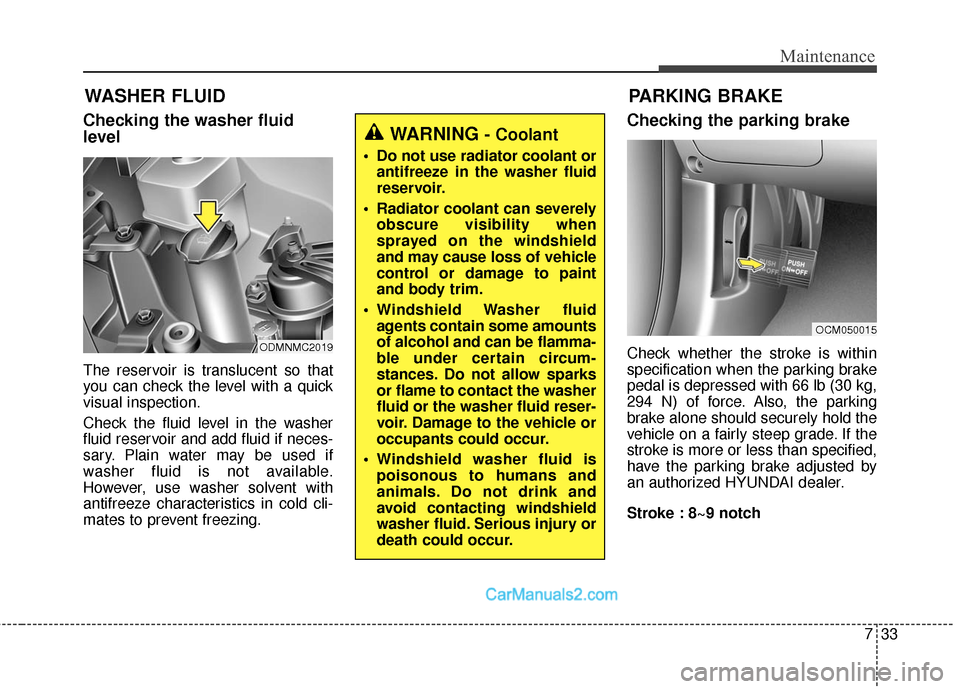
733
Maintenance
WASHER FLUID
Checking the washer fluid
level
The reservoir is translucent so that
you can check the level with a quick
visual inspection.
Check the fluid level in the washer
fluid reservoir and add fluid if neces-
sary. Plain water may be used if
washer fluid is not available.
However, use washer solvent with
antifreeze characteristics in cold cli-
mates to prevent freezing.
Checking the parking brake
Check whether the stroke is within
specification when the parking brake
pedal is depressed with 66 lb (30 kg,
294 N) of force. Also, the parking
brake alone should securely hold the
vehicle on a fairly steep grade. If the
stroke is more or less than specified,
have the parking brake adjusted by
an authorized HYUNDAI dealer.
Stroke : 8~9 notchODMNMC2019
WARNING - Coolant
Do not use radiator coolant orantifreeze in the washer fluid
reservoir.
Radiator coolant can severely obscure visibility when
sprayed on the windshield
and may cause loss of vehicle
control or damage to paint
and body trim.
Windshield Washer fluid agents contain some amounts
of alcohol and can be flamma-
ble under certain circum-
stances. Do not allow sparks
or flame to contact the washer
fluid or the washer fluid reser-
voir. Damage to the vehicle or
occupants could occur.
Windshield washer fluid is poisonous to humans and
animals. Do not drink and
avoid contacting windshield
washer fluid. Serious injury or
death could occur.
PARKING BRAKE
OCM050015
Page 552 of 614
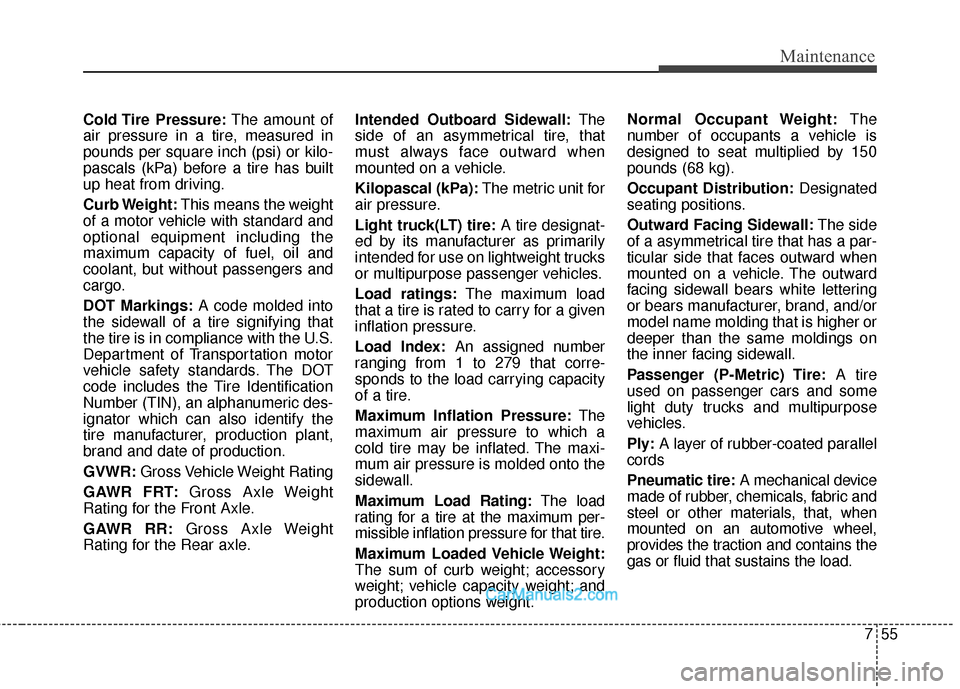
755
Maintenance
Cold Tire Pressure:The amount of
air pressure in a tire, measured in
pounds per square inch (psi) or kilo-
pascals (kPa) before a tire has built
up heat from driving.
Curb Weight: This means the weight
of a motor vehicle with standard and
optional equipment including the
maximum capacity of fuel, oil and
coolant, but without passengers and
cargo.
DOT Markings: A code molded into
the sidewall of a tire signifying that
the tire is in compliance with the U.S.
Department of Transportation motor
vehicle safety standards. The DOT
code includes the Tire Identification
Number (TIN), an alphanumeric des-
ignator which can also identify the
tire manufacturer, production plant,
brand and date of production.
GVWR: Gross Vehicle Weight Rating
GAWR FRT: Gross Axle Weight
Rating for the Front Axle.
GAWR RR: Gross Axle Weight
Rating for the Rear axle. Intended Outboard Sidewall:
The
side of an asymmetrical tire, that
must always face outward when
mounted on a vehicle.
Kilopascal (kPa): The metric unit for
air pressure.
Light truck(LT) tire: A tire designat-
ed by its manufacturer as primarily
intended for use on lightweight trucks
or multipurpose passenger vehicles.
Load ratings: The maximum load
that a tire is rated to carry for a given
inflation pressure.
Load Index: An assigned number
ranging from 1 to 279 that corre-
sponds to the load carrying capacity
of a tire.
Maximum Inflation Pressure: The
maximum air pressure to which a
cold tire may be inflated. The maxi-
mum air pressure is molded onto the
sidewall.
Maximum Load Rating: The load
rating for a tire at the maximum per-
missible inflation pressure for that tire.
Maximum Loaded Vehicle Weight:
The sum of curb weight; accessory
weight; vehicle capacity weight; and
production options weight. Normal Occupant Weight:
The
number of occupants a vehicle is
designed to seat multiplied by 150
pounds (68 kg).
Occupant Distribution: Designated
seating positions.
Outward Facing Sidewall: The side
of a asymmetrical tire that has a par-
ticular side that faces outward when
mounted on a vehicle. The outward
facing sidewall bears white lettering
or bears manufacturer, brand, and/or
model name molding that is higher or
deeper than the same moldings on
the inner facing sidewall.
Passenger (P-Metric) Tire: A tire
used on passenger cars and some
light duty trucks and multipurpose
vehicles.
Ply: A layer of rubber-coated parallel
cords
Pneumatic tire: A mechanical device
made of rubber, chemicals, fabric and
steel or other materials, that, when
mounted on an automotive wheel,
provides the traction and contains the
gas or fluid that sustains the load.
Page 588 of 614
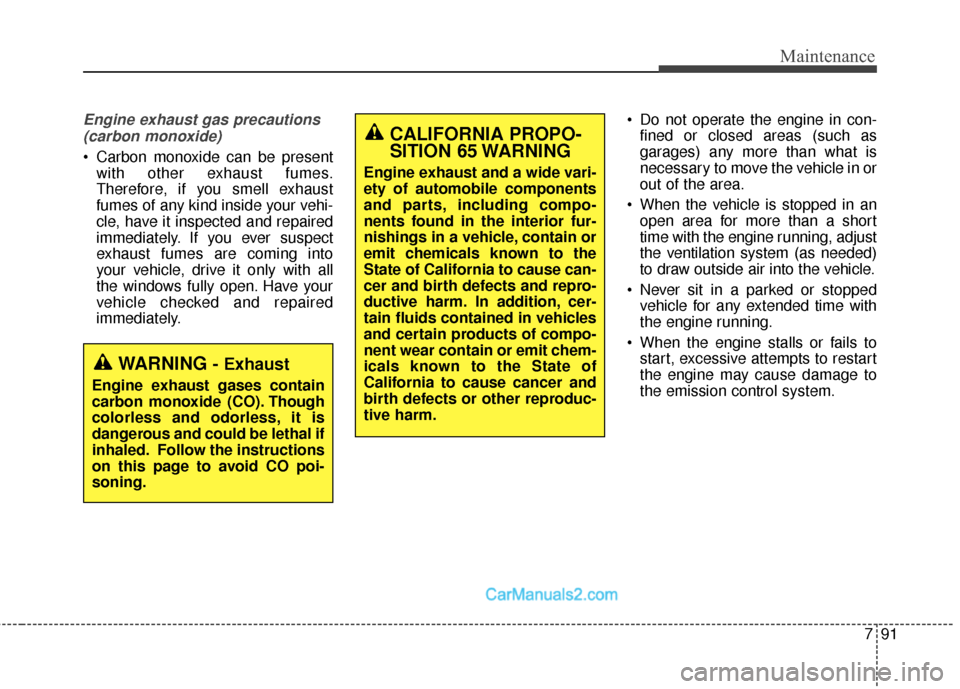
791
Maintenance
Engine exhaust gas precautions(carbon monoxide)
Carbon monoxide can be present with other exhaust fumes.
Therefore, if you smell exhaust
fumes of any kind inside your vehi-
cle, have it inspected and repaired
immediately. If you ever suspect
exhaust fumes are coming into
your vehicle, drive it only with all
the windows fully open. Have your
vehicle checked and repaired
immediately. Do not operate the engine in con-
fined or closed areas (such as
garages) any more than what is
necessary to move the vehicle in or
out of the area.
When the vehicle is stopped in an open area for more than a short
time with the engine running, adjust
the ventilation system (as needed)
to draw outside air into the vehicle.
Never sit in a parked or stopped vehicle for any extended time with
the engine running.
When the engine stalls or fails to start, excessive attempts to restart
the engine may cause damage to
the emission control system.
CALIFORNIA PROPO-
SITION 65 WARNING
Engine exhaust and a wide vari-
ety of automobile components
and parts, including compo-
nents found in the interior fur-
nishings in a vehicle, contain or
emit chemicals known to the
State of California to cause can-
cer and birth defects and repro-
ductive harm. In addition, cer-
tain fluids contained in vehicles
and certain products of compo-
nent wear contain or emit chem-
icals known to the State of
California to cause cancer and
birth defects or other reproduc-
tive harm.
WARNING - Exhaust
Engine exhaust gases contain
carbon monoxide (CO). Though
colorless and odorless, it is
dangerous and could be lethal if
inhaled. Follow the instructions
on this page to avoid CO poi-
soning.
Page 596 of 614
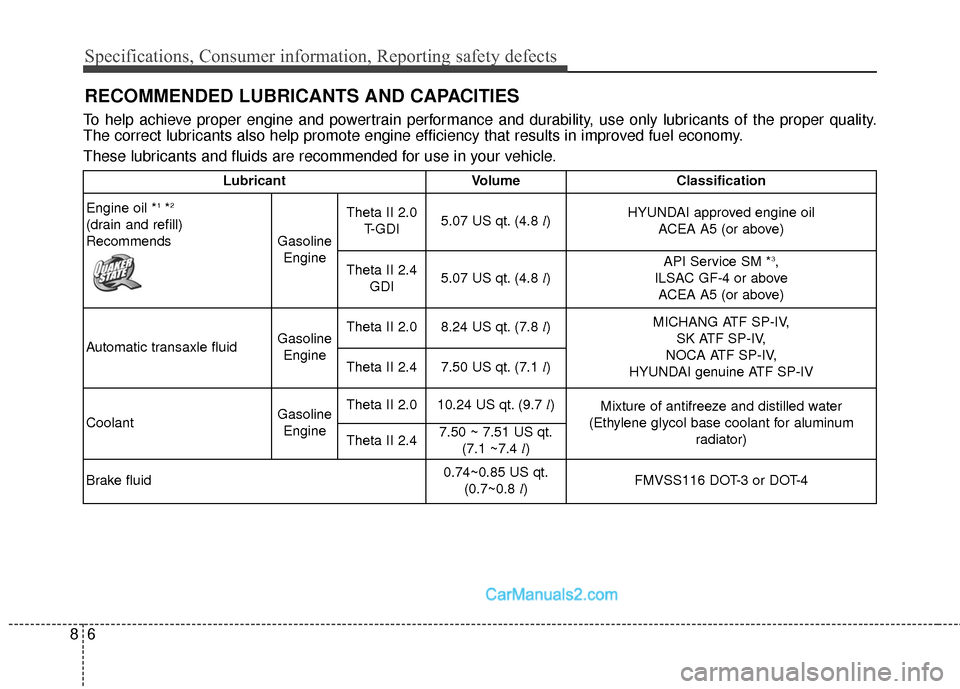
Specifications, Consumer information, Reporting safety defects
68
RECOMMENDED LUBRICANTS AND CAPACITIES
To help achieve proper engine and powertrain performance and durability, use only lubricants of the proper quality.
The correct lubricants also help promote engine efficiency that results in improved fuel economy.
These lubricants and fluids are recommended for use in your vehicle.
LubricantVolumeClassification
Engine oil *
1*2
(drain and refill)
Recommends Gasoline EngineTheta II 2.0
T-GDI 5.07 US qt. (4.8
l)HYUNDAI approved engine oil
ACEA A5 (or above)
Theta II 2.4 GDI 5.07 US qt. (4.8
l) API Service SM *
3,
ILSAC GF-4 or above ACEA A5 (or above)
Automatic transaxle fluid Gasoline
Engine Theta II 2.0
8.24 US qt. (7.8
l) MICHANG ATF SP-IV,
SK ATF SP-IV,
NOCA ATF SP-IV,
HYUNDAI genuine ATF SP-IV
Theta II 2.4
7.50 US qt. (7.1
l)
Coolant Gasoline
Engine Theta II 2.0
10.24 US qt. (9.7
l)
Mixture of antifreeze and distilled water
(Ethylene glycol base coolant for aluminum radiator)
Theta II 2.4 7.50 ~ 7.51 US qt.
(7.1 ~7.4 l)
Brake fluid 0.74~0.85 US qt.
(0.7~0.8 l) FMVSS116 DOT-3 or DOT-4
Page 605 of 614
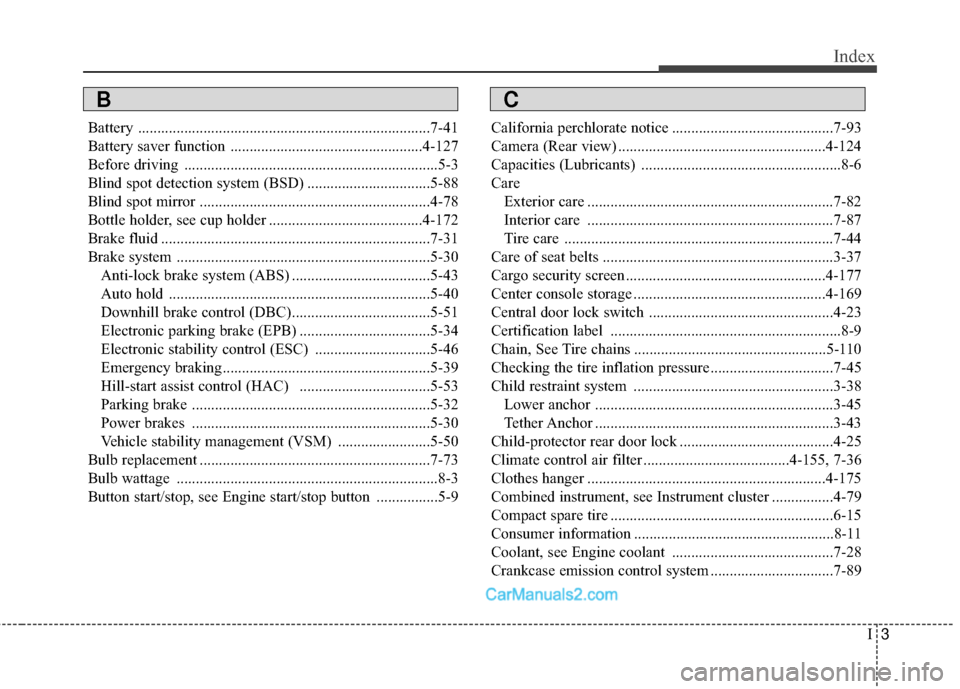
I3
Index
Battery ........................................................................\
....7-41
Battery saver function ..................................................4-127
Before driving ..................................................................5-3
Blind spot detection system (BSD) ................................5-88
Blind spot mirror ............................................................4-78
Bottle holder, see cup holder ........................................4-172
Brake fluid ......................................................................7-\
31
Brake system ..................................................................5-30Anti-lock brake system (ABS) ....................................5-43
Auto hold ....................................................................5-40\
Downhill brake control (DBC)....................................5-51
Electronic parking brake (EPB) ..................................5-34
Electronic stability control (ESC) ..............................5-46
Emergency braking......................................................5-39
Hill-start assist control (HAC) ..................................5-53
Parking brake ..............................................................5-32
Power brakes ..............................................................5-30
Vehicle stability management (VSM) ........................5-50
Bulb replacement ............................................................7-73
Bulb wattage ....................................................................8-3
Button start/stop, see Engine start/stop button ................5-9 California perchlorate notice ..........................................7-93
Camera (Rear view) ......................................................4-124
Capacities (Lubricants) ....................................................8-6
Care
Exterior care ................................................................7-82
Interior care ................................................................7-87
Tire care ......................................................................7-\
44
Care of seat belts ............................................................3-37
Cargo security screen ....................................................4-177
Center console storage ..................................................4-169
Central door lock switch ................................................4-23
Certification label ............................................................8-9
Chain, See Tire chains ..................................................5-110
Checking the tire inflation pressure ................................7-45
Child restraint system ....................................................3-38 Lower anchor ..............................................................3-45
Tether Anchor ..............................................................3-43
Child-protector rear door lock ........................................4-25
Climate control air filter ......................................4-155, 7-36
Clothes hanger ..............................................................4-175
Combined instrument, see Instrument cluster ................4-79
Compact spare tire ..........................................................6-15
Consumer information ....................................................8-11
Coolant, see Engine coolant ..........................................7-28
Crankcase emission control system ................................7-89
BC
Page 607 of 614

I5
Index
Engine number ................................................................8-10
Engine oil ........................................................................\
7-26
Engine overheat ................................................................6-8
Engine start/stop button ....................................................5-9
Engine will no start ..........................................................6-4
Explanation of scheduled maintenance items ................7-23
Interior care ....................................................................7-87\
Exterior features............................................................4-180
Exterior overview (front) ..................................................2-2
Exterior overview (rear) ..................................................2-3
Flat tire (with spare tire) ................................................6-15Changing tires..............................................................6-18
Compact spare tire ......................................................6-22
Jack and tools ..............................................................6-15
Jack label ....................................................................6-24\
Floor mat anchor(s) ......................................................4-175
Fluid Brake fluid ..................................................................7-31
Washer fluid ................................................................7-33
Folding key ......................................................................4-\
4
Folding the rear seat ......................................................3-22
Front fog light ..............................................................4-132
Front seat adjustment - Manual ........................................3-7
Front seat adjustment - Power ..........................................3-8 Front wiper deicer ........................................................4-146
Fuel Economy ..............................................................4-103
Fuel filler door ................................................................4-46
Fuel filler door manual release....................................4-49
Fuel gauge ......................................................................4-\
82
Fuel requirements ............................................................1-2
Fuses switch ....................................................................7-62\
Fuses ........................................................................\
......7-60 Engine compartment panel fuse ..................................7-62
Fuse/relay panel description ........................................7-64
Fuses switch ................................................................7-62
Instrument panel fuse ..................................................7-61
Multi fuse ....................................................................7-63\
Gauges ........................................................................\
....4-80
Glove box......................................................................4-\
169
Good braking practices ..................................................5-54
Good driving practices....................................................5-19
Gross vehicle weight ........................................................8-5
F
G
Page 614 of 614
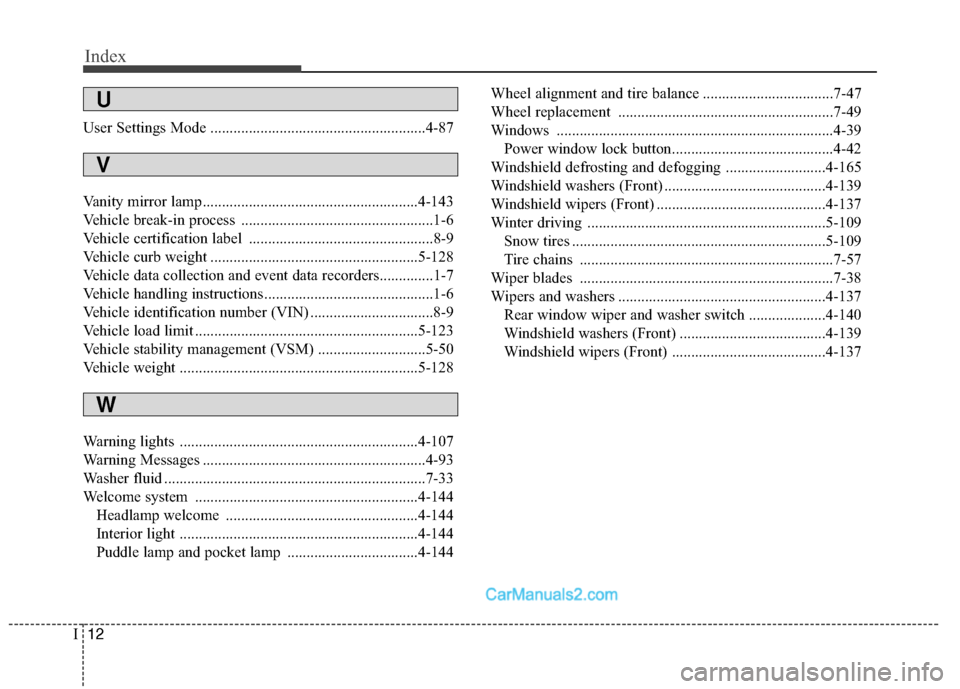
Index
12I
User Settings Mode ........................................................4-87
Vanity mirror lamp........................................................4-143
Vehicle break-in process ..................................................1-6
Vehicle certification label ................................................8-9
Vehicle curb weight ......................................................5-128
Vehicle data collection and event data recorders..............1-7
Vehicle handling instructions............................................1-6
Vehicle identification number (VIN) ................................8-9
Vehicle load limit ..........................................................5-123
Vehicle stability management (VSM) ............................5-50
Vehicle weight ..............................................................5-128
Warning lights ..............................................................4-107
Warning Messages ..........................................................4-93
Washer fluid ....................................................................7-33\
Welcome system ..........................................................4-144Headlamp welcome ..................................................4-144
Interior light ..............................................................4-144
Puddle lamp and pocket lamp ..................................4-144 Wheel alignment and tire balance ..................................7-47
Wheel replacement ........................................................7-49
Windows ........................................................................\
4-39
Power window lock button..........................................4-42
Windshield defrosting and defogging ..........................4-165
Windshield washers (Front) ..........................................4-139
Windshield wipers (Front) ............................................4-137
Winter driving ..............................................................5-109 Snow tires ..................................................................5-109
Tire chains ..................................................................7-57
Wiper blades ..................................................................7-38
Wipers and washers ......................................................4-137 Rear window wiper and washer switch ....................4-140
Windshield washers (Front) ......................................4-139
Windshield wipers (Front) ........................................4-137
U
V
W